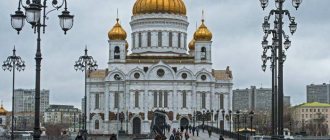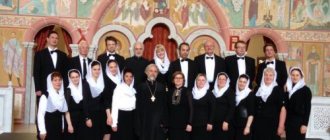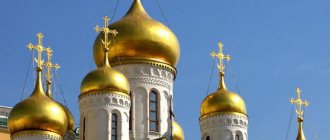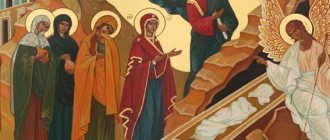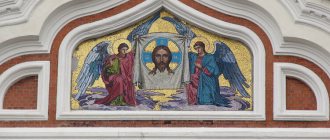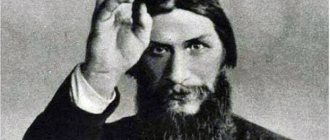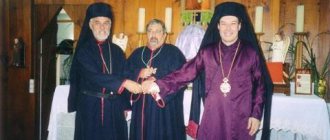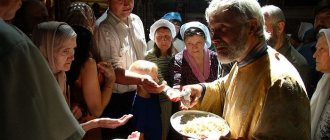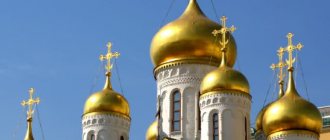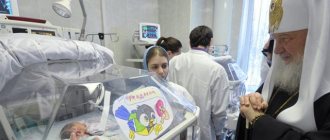The beginning of the infringement of Christianity in Rus'
It is generally accepted that the persecution of Orthodoxy in Russia began in 1917 with the Red Revolution and the arrival of the Bolsheviks, but this is not so. The Orthodox were ridiculed and experienced difficulties much earlier and throughout the history of their existence, however, those problems were temporary and usually ended with a change of ruler.
Persecution of the church began with the reign of Emperor Alexei (father of Peter I)
The clergy believes that the terror of the Russian Orthodox Church began much earlier, during the reign of Peter I and continued throughout the entire 18th century, and the Bolsheviks were only a consequence of those persecutions, and their power became the most destructive.
On a note! Many fathers believe that the revolution is a punishment for the imperial court, which neglected faith in God.
The first signs of persecution can be found by familiarizing yourself with the reforms of various rulers of Rus':
- In 1503, under the reign of John III, the Russian Orthodox Church was deprived of its monastic possessions.
- In 1721, under Peter I, the patriarchate was abolished and the Holy Synod was created.
- In 1730-1740 under the reign of Anna Ioannovna, there was a general reduction in the number of monks and their forced inclusion in the state army. Confiscation of property and lands belonging to monasteries.
- The accession of Elizabeth Petrovna to the throne and her reign during 1741 - 1761. brought relief to the believers, but at the same time the Freemasons strengthened at court, which accelerated the split between the authorities and the metropolitans.
- In 1764, after the accession of Catherine the Great, more than 2/3 of all monastery farmsteads were closed, parish lands were taken into the treasury, and monastery staffs were established.
Simultaneously with tough reforms and laws that tighten the functioning of the Russian Orthodox Church, a mass of heresies are spreading in Rus' that undermine the foundations of churches and the faith of Christians in general. During the 17th-18th centuries, not only was a huge heritage destroyed, but numerous clergy were executed or sent into exile, starting with Patriarch Nikon, who was deprived of his status and sent into exile, where he died in 1666.
The creation of the Holy Synod significantly influenced the position of the church in the state. As a result of its creation, leaders of the Russian Orthodox Church were subjected to secular trials, and all cases of defense of Orthodoxy and resistance to Protestantism were classified as criminal and political. Many monks, hierarchs and clerics were subjected to torment and torture, sent into exile and died a violent death.
Theologians are mostly inclined to believe that persecution began with the reign of Emperor Alexei Mikhailovich, when Russia began to slowly succumb to the influence of Western Europe. As you know, it was the Catholics and Protestants of Europe who were categorically dissatisfied with the existing interaction between the clergy and the authorities in the empire, so they took a lot of steps to destroy it.
Read about other religions:
- Orthodoxy and Islam
- Orthodoxy and Baptism
- Orthodoxy and Judaism
Churches and other organizations of the Russian Orthodox Church at the beginning of the twentieth century (before 1917)
M.Yu. Smirnov, DYNAMICS OF RELIGIOUS ORGANIZATIONS IN PRE-REVOLUTIONARY RUSSIA: historical and statistical review, Part 9
Revolutionary events of the early twentieth century. The church body was not spared. The highest clergy revealed a clear clerical bias, and the parish clergy became noticeably politicized. In the First State Duma, all the priests elected there joined the left and the center, and the two elected bishops joined the right factions. In the Second Duma, both bishops supported the right and the Octobrists; among the 20 elected priests there were three Cadets, four Socialist Revolutionaries, four joined the right. In the Third Duma, four priests joined the centrist faction, nine joined the Octobrist faction, 13 priests and one bishop joined the moderate right faction, two joined the nationalists, one archbishop and 15 priests joined the right-wing monarchists. There were already 46 clergy in the Fourth Duma, of which six priests belonged to the centrists, 19 were moderate right-wingers, and another 19 and both bishops joined the extreme right.
In 1905, the Russian Orthodox Church had 66 dioceses, 48,375 cathedrals and parish churches, 20,583 chapels and houses of worship; the clergy (including the lower clergy) numbered more than 103 thousand people; clergy personnel were trained in 4 theological academies, 57 theological seminaries, 184 men's theological schools; there were also 74 women's schools of the ecclesiastical department (of which 61 were diocesan); There were 860 monasteries (67,720 monastics and novices).
The composition of the monasteries was of different levels. Large ones stood out - four laurels (Trinity-Sergius, Alexander Nevskaya, Kiev-Pecherskaya, Pochaevskaya), seven stauropegial monasteries. Along with hundreds of “averagely populated” monasteries, there were also relatively small ones in terms of the number of monastics: deserts - 86 (12), monasteries - 68 (13), cenovia - four. Until the beginning of the twentieth century. 20 male and 10 female monasteries simultaneously served as places of detention. They were released from this function only in 1905–1907. The largest and oldest (since 1554) monastery prison was Solovetskaya (closed in 1902). From the circus. lyric decrees of the Synod for 1867–1900. It followed that church officials alone were exiled to monasteries annually for various offenses, on average up to 900 people.
Statistics of land ownership for 50 provinces of central Russia indicate that on their territory at the beginning of the 20th century. Orthodox monasteries owned 739,777 acres of land (the Solovetsky Monastery had 66 thousand acres of land, the Alexander Nevsky Lavra - 13 thousand acres, the Trinity-Sergius Lavra - 2 thousand acres). More than 1.8 million dessiatines were owned by churches, 337 thousand dessiatines belonged to members of the clergy as private property. The total size of church land ownership in 1905 was 2,611,636 dessiatines.
The maintenance of the Orthodox clergy consisted of regular salaries, funds from the fulfillment of requirements, income from land holdings, and voluntary donations from the flock. The financial policy of the Russian state also contributed to the strengthening of church opportunities. A procedure for permanent benefits to clergy was in effect. In 1905, the clergy of 27,412 churches received them; in 1907, the clergy of 38,413 parish churches received 12.3 million rubles from the state treasury. 115 By 1914 The annual state subsidy to the Church amounted to 18 million rubles. According to other sources, state allocations for the needs of the Orthodox Church amounted to 29.3 million rubles in 1905, and in 1914 they rose to 53.9 million rubles. 117 Total revenues from all sources for 1914, according to the Synod’s estimates, reached 110.3 million rubles. At the same time, the Holy Synod did not publish reports on its expenses, and the reports of the chief prosecutors contained only isolated data.
Of particular relevance for the Church at the turn of the 19th and 20th centuries. had professional training for priests and theologians: the available level clearly lagged behind the aggravated demands of the time. For 1900–1910 all four theological academies graduated more than 1,600 people, but by 1911 only 700 priests with academic education served in parishes and non-parish churches. Many “academicians” went to secular service. The seminar environment experienced the revolutionary sentiments of the early twentieth century. In 1905, strikes took place in 18 theological seminaries. The number of students in theological educational institutions did not change significantly over the course of 20 years: in 1894 - 901 people in academies, 18,749 - in seminaries, 30,896 - in theological schools; for 1910, respectively - 903, 21,075, 28,124; for 1914 - 995, 22,734, 29,419 people. The number of teachers in theological seminaries decreased from 1091 in 1894 to 947 in 1914. At the same time, however, subsidies from the treasury for institutions of theological education increased: in 1894 they amounted to 1,619,318 rubles, and in 1913 already RUB 3,299,404 (the Synod’s expenses in this area in 1905–1913 amounted to 5–6 million rubles annually).
In 1912, there were 53,902 churches and 23,204 chapels with a clergy totaling 110,970 people; in 985 monasteries there were 86,854 monastics and novices 122. During the first 17 years of the 20th century. 177 new monasteries were founded. Income. bishops' houses, laurels and monasteries also increased. According to V.V.’s calculations Morozan, by January 1, 1910 they owned 61 million rubles. in securities and about 1.4 million rubles. in cash; 21.5 million rubles were added to this. total income from mug collection, sale of candles, rent collection, interest on capital in banks, donations from parishioners, etc., as well as 1 million rubles received from the treasury for their annual maintenance. In 1913 the amount of monastery bank deposits amounted to 65.6 million rubles. In 1910, the monastery operated 202 hospitals and 104 almshouses; by 1914, this number had grown to 234 hospitals (2,698 beds) and 169 almshouses (2,252 beds); during the First World War, according to P.N. Zyryanov, infirmaries were opened in 207 monasteries (of which 139 were actually monasteries). State. support for this area continued during wartime: in 1916, for example, 275 monasteries received another 423.5 thousand rubles in addition to their own income. government content.
The statistical characteristics of the Orthodox Russian Church at the final stage of the synodal period of its history (1914–1917) present some complexity. On the one hand, there are various church and state documents, according to which the picture should look relatively complete and close to authenticity. On the other hand, an accurate accounting of the actual state of the Church in the mentioned period was already complicated by the ongoing socio-political events and was far from possible in everything. In Soviet times, the attitude to statistical information was often arbitrary and selective, and much was simply lost. Data disseminated in domestic publications, even based on identical sources, often differ markedly. From these materials, in a brief generalized form, the position of Orthodox church organizations is presented as follows.
Regarding the size of the Orthodox flock at the time in question, one has to rely only on formal quantitative data. According to a modern domestic researcher, “... in pre-revolutionary Russia, characterizing the state of religiosity in society was the prerogative of state statistics bodies.” Belonging to any religion was recorded on the basis of church registration of births and baptisms for Christians or corresponding acts adopted for non-Christian religions. Such identification did not take into account either the level of religiosity (whether the person remained a practicing believer or did not observe religious institutions), or the possible non-denominational state of being “enrolled” in a confession.
Magazine “State, Religion, Church in Russia and Abroad”, No. 3 2010
www.gazetaprotestant.ru
The history of persecution of the Russian Orthodox Church in the twentieth century
Any persecution always began with lies and slander. If in the first centuries the lie about cannibalism among Christians was widespread, then in Soviet times there was an opinion that believers were narrow-minded and stupid people who wanted to overthrow socialism and bring capitalism to the country. The intelligentsia waged an active struggle against believers - they fought against faith with poems by Mayakovsky and Bedny, films by Eisenstein, and stories by Gorky.
The Soviet government viewed religion as a social relic
Moreover, much worse was the inaction of all other representatives of this educated class. Many churches were closed, hundreds of people were killed, all valuables were taken away and more than 1000 members of the clergy were exiled, and the creative intelligentsia simply tried not to notice this.
The main reasons for persecution in the USSR can be called:
- Fear of government officials to lose influence or share it with the Russian Orthodox Church.
- Fear of losing power due to possible anti-revolutionary activities of the church.
Fear of losing influence on the people led the Bolsheviks to the decision to destroy religious organizations. They succeeded in this - no one persecuted Christians so sophisticatedly: reproach, discredit, denunciations, arrests, torture, hard labor, executions. At the same time, the communists not only fought from the outside - they did a huge amount of work to infiltrate and disintegrate the parishes from the inside.
Lenin period
Lenin's position in relation to the church is quite transparent - he considered religion to be the opium of the people and called for a fight against religious prejudices. His main idea was to fight with “quiet methods” - propaganda and inciting the population against the clergy. He viewed faith as a religious prejudice and sought to raise the general consciousness of the masses so that they would independently begin to fight the Russian Orthodox Church. This allowed him to somewhat hide his positions and not attract loud attention from the public, which at that time did not yet submit so unconditionally to the highest authority.
In 1917, all land resources owned by the Russian Orthodox Church were nationalized in accordance with the decree “On Land”. The clergy, for their part, sought to occupy a privileged position and at the Council of December 2, 1917, adopted the corresponding provisions, however, the Bolsheviks refused to agree with them and mutual antagonism intensified. Already in February 1918, the board adopted the Decree “On the separation of church from state and school,” which deprived the church of property rights and consolidated the secular character of the country.
During the reign of V.I. Lenin also faces a campaign to uncover the relics - targeted actions to destroy valuables.
Seizure of church valuables
The civil war and the general religiosity of the people prevented active actions of the communists against the faith and there were no high-profile campaigns to seize property, although it was during the Civil War that a lot of bloody clashes between the clergy and the army took place. After the end of the revolution and war, already at the end of the 1920s, the process of destroying the Russian Orthodox Church began again, but this time it did not stop and almost destroyed it in the USSR. Impunity led to an attack on the peasantry, its partial humiliation through collectivization, and sharply increased anti-church terror. During this period, the number of those arrested for their faith was 3 times higher than the number of those repressed during the Civil War.
Stalin period
Stalin, like his teacher Lenin, believed that the destruction of the Church was an important and necessary condition for the formation of the Soviet leadership. Although initially the struggle for international recognition, attempts to bring the country out of a deep crisis (NEP policy) somewhat weakened the persecution. In 1922 - 1927 there was a noticeable pause in matters of religion.
At this time, the GPU began its work - the state political administration, whose activities were the deliberate discrediting and decomposition of the Church from within. Under Stalin's rule, Trotsky's plan (it dates back to 1922) began to be put into action and its result was the emergence of a renovationist clergy - figureheads introduced reforms, trying to make churches and parishes more modern (according to them), but in fact they brought confusion and subjugated the clergy communist party.
In 1929, the campaign for the total destruction of the Russian Orthodox Church began again.
In the 1920s and 1930s, most churches were rural, and active collectivization simply destroyed them, as well as possible defenders of the faith. Along with the destruction, robberies and destruction of parishes, clergy are also destroyed - more than 10,000 clergy were arrested, exiled to Siberia or shot. Rural priests, even those who were loyal to the Soviet regime, were destroyed (after 1929, every third one was shot), the entire clergy was enrolled as counter-revolutionaries.
Times of Revolution and Civil War
Despite all the efforts of the Bolsheviks, in December 1937, during a survey of the population, more than 58% (2/3 of rural and 1/3 of urban) admitted themselves to be believers, despite the risk of arrest and execution. In the closed documentation of the communists of that time, only 10% of the population was recognized as atheists, despite 20 years of anti-religious activity. After such statistics, Stalin decides to conduct a repressive campaign against such anti-Soviet elements.
As a result of the arrests, the unwanted authorities were sent to prison for 8 and 10 years, and most of the clergy were executed. The campaign lasted from August 1937 to the spring of 1938 and brought horrific results - more than 32,000 believers were arrested, half of them were executed. The Great Patriotic War and the subsequent years of reconstruction brought a relaxation of terror.
Stalin's rule was characterized by extreme cruelty in general: the bloody imposition of Soviet power by exterminating all dissenters or those suspected of anti-state activities led to the almost complete destruction of the peasantry (which was the main stronghold of the Russian Orthodox Church), the intelligentsia and the clergy.
Khrushchev period
Khrushchev's coming to power not only did not ease the pressure on the RPU, but, on the contrary, marked a new wave of terror. It was Nikita Sergeevich who made the famous promise to show the last priest on TV, because by 1980 he promised to build a pure communist regime in the USSR. The only difference between Khrushchev’s persecutions and Stalin’s was the absence of blood, since Nikita Sergeevich chose economic and propaganda methods of struggle.
An atheistic newspaper published in the Soviet Union
Propaganda in 1953-1964 reached unprecedented proportions. As a result of active actions of the state apparatus during the reign of Khrushchev:
- The number of monasteries decreased by 4 times, and the number of parishes by 2 times.
- 5 of the 8 seminaries that opened after the war were closed.
- 5-6 books with anti-religious content were published per day (!).
- Believers were registered as dangerous social elements.
- The monks of the Pochaev Lavra were forcibly removed and registered in mental hospitals. Believers were forcibly treated with psychotropic drugs.
- Defenders and people devoted to the faith were thrown into prison and tortured in an attempt to turn them into renunciants.
- More than 200 ministers renounced their faith and were anathematized.
- 1,234 people were convicted on religious grounds.
Despite the active efforts of the authorities (anti-religious propaganda was incredibly powerful in those years) and the loss of half of the property (by 1966, out of 13,478 churches in the country, only 7,523 remained), as well as many casualties, the religiosity of the population did not decrease. According to parishes, in these years, on the contrary, the number of rituals performed has increased.
Persecution became a litmus test for many: some gave their lives and freedom for the privilege of being called a Christian, while others chose to renounce the Savior Christ and become traitors, serving a destructive and bloody power.
Introduction
Author: Pospelovsky, Dmitry Vladimirovich
Constantine's legacy and the crisis of Orthodoxy in the 20th century
To understand the tragedy of the Orthodox Church in Russia in the 20th century, it is not enough to limit ourselves only to its post-revolutionary history. It is also necessary to look at the crisis of Orthodoxy historically, bearing in mind the foundations of the relationship between the Church and the state, laid in the era of Emperor Constantine and his immediate successors. This protracted Constantine era was put to an end by the decree of the Council of People's Commissars of the RSFSR of January 23, 1918, “On the separation of church from state and school from church.” However, in the light of the persecutions that followed this decree, which lasted seven decades, many see the pre-revolutionary era and church “Constantinism” almost as a kind of “golden age”, and dreams of a return to it are not uncommon. Therefore, it is necessary to reflect on the essence of “Constantinism” and on what its implementation logically led to throughout the historical path of Russia.
So, in 313, Emperor Constantine the Great proclaimed Christianity an officially equal religion throughout the Roman Empire, and in 380, Emperor Theodosius the Great declared Christianity the only legitimate state religion of the empire. And here several temptations immediately arose, which can be called the heresy of Caesar-papism. First, Constantine's victory at Rome in 312, which resulted in the legalization of Christianity, was associated with Constantine's mystical experience: he had some kind of apparition in a dream with instructions to inscribe a Christian sign - apparently a cross - on a weapon. From that moment on, Constantine considered himself a Christian, although he was baptized only on his deathbed, and then, apparently, by an Arian heretic. From this it followed that baptism and the Eucharistic life of the Church were, as it were, optional for the emperor, unlike mere mortals; it is as if he received his Christianity directly from God, and not through the Church 1.
The fact is that Constantine not only patronized the Church, formally remaining a pagan, but also convened the First Ecumenical Council, presided over it, and intervened in theological disputes. Later, taking the side of the Arians, he actively and very cruelly persecuted Orthodoxy, including St. Athanasius. There were also no signs of holiness in the life of Constantine: he killed both his brother and his own son. And yet he argued
9
that he had the gift of mystical visions, and, according to Fr. Alexander Schmemann, Constantine undoubtedly strove for God with his soul and dreamed of being baptized in the Jordan 2. The fact that the Church nevertheless canonized him as a saint seems to say that Caesar is above the Church, independent of it. Is this not where the ease with which crowned persons, whose holiness is very doubtful, are canonized in our country - from Alexander Nevsky and Dmitry Donskoy to Nicholas II?
In vain we will look in the Gospel or the writings of the church fathers for theological justification of such Caesar-papism. But the emergence of this early heresy in the history of the Church is humanly and psychologically quite understandable. After all, the era of Constantine came after three centuries of severe persecution of Christianity. And so, coming out of hiding, the Christians rejoiced: the era of Christianity has come, the emperor is a Christian, which means he is a messenger, the anointed one of God. After all, this was the time of early Christianity, which was awaiting the imminent coming of Christ, the onset of his thousand-year kingdom... It seemed that all this was coming true. And those same Christians who were often tortured for refusing to provide divine honors to pagan emperors were now ready to deify a Christian emperor.
However, under Emperor Justinian in the 6th century. the doctrine of the symphony appears, which seemed to put everything in its place: what is God's to God, what is Caesar's to Caesar. But we must remember that this was a union of the extremely centralized for that time, dictatorial-absolutist power of the emperor with a decentralized Church, which existed in the form of many completely independent dioceses, united only by periodically convened councils. True, having become the state religion, the Church is gradually, as it were, centralized. Bishops of capital cities become senior in position over other bishops of the region; and five bishops sitting in the most important cities of the empire begin in the 5th century. be called patriarchs, of whom the first among equals is the bishop of Rome - the pope. The doctrine of the symphony does not clearly define the powers of the patriarch. However, the emperor is spoken of as the supreme earthly head of all Christians, who is also responsible for the Church. This applies to the entire Roman Empire. And the popes also fully accepted this doctrine, giving virtually sacred honors to the emperors. But historically it turned out that in the Western Roman Empire in the 5th century. its last emperor was deposed and the pope actually occupies the vacant position of the Roman emperor, which completely changes the entire history of Western Christianity and its relationship with secular power.
In Byzantium, the emperors, starting with Constantine, actually led the Church. They interfered not only in its governance, leaving themselves the last word in electing patriarchs, but also in theological issues, and often very ignorantly, supporting either the Arians or the iconoclasts. The Church's response to these
10
conditions there could be, and was, only martyrdom. 3 But if at first the readiness for martyrdom was a mass phenomenon, which ultimately led to the victory of Orthodoxy, including the victory of the icon venerators, then as the official Church became “official,” this readiness became an exception in the behavior of Christians. A contrasting illustration of this is, for example, the case of Metropolitan Isidore, who represented the Russian Orthodox Church at the Ferraro-Florentine Ecumenical Council (1438-1439), after his return from Florence, where he signed a union with the Catholic Church. Returning, Isidore commemorated the pope at divine services, for which he was overthrown and imprisoned, not by his brother bishops, but by Grand Duke Vasily the Dark, who did not accept the union.
Nevertheless, the Russian Orthodox Church in relation to the grand-ducal power in Russia (at least until the end of the 15th century) was incomparably freer than the Byzantine Church in relation to the emperor. And here we come to the periodization of the history of the Russian Orthodox Church.
Historian Anton Kartashev divides the history of the Church in Russia into four periods.4 The first is Kievan Rus. Two factors play a big role here: neophyteism associated with the admiration of princes for the authority of the Church, which came from the brilliant Byzantium; a certain extraterritoriality of it. For the first three centuries after Baptism, the metropolitans in Rus', with rare exceptions, were Greeks or Balkan Greek Slavs. They were sent to Rus' by the emperor himself, and ordained by the Ecumenical Patriarch himself. Who, in comparison with them, and therefore with their representative metropolitan, was the Prince of Kiev, and even more so the Prince of Polotsk or some Suzdal prince? Just a barbarian orchon.
According to M. Priselkov, the Church during this period directs the process of creating Russian statehood. Monastic chroniclers, calling on the Russian princes for peace among themselves, for the creation of a united Rus', put forward a model of a church council: both bishops, who, being masters in their dioceses, recognize the primacy of the Kiev Metropolitan, and the princes must recognize the primacy of the Kyiv prince. Just as bishops gather at periodic councils under the chairmanship of the Kyiv Metropolitan to resolve and coordinate the affairs of the national Church, so princes must resolve their disputes. Priselkov sees an example of such imitation of church councils as the princely congress in Lyubech in 1097 and a number of subsequent such congresses. 5 And of course, zemstvo cathedrals of the 16th-17th centuries. were created according to the model of Consecrated local cathedrals.
Kartashev considers the next stage or period in the history of the Russian Orthodox Church to be the era of the Tatar yoke. The church was placed in a privileged position by the Tatars. She was exempt from all taxes. The Tatars had great respect for Christianity and its clergy. While they were exhausting the Russian principalities with extortions, conscription, demands for tribute and frequent raids, monasteries and temples, like
11
As a rule, they enjoyed complete immunity. Consequently, only in the monasteries was direct continuity from Kievan Rus preserved. Moreover, only the Metropolitan of Kiev in his title reminded of Rus' as such, while it was all fragmented into appanages and a resident of Smolensk called himself a Smolenian, and the Prince of Ryazan was the Prince of Ryazan. But neither one nor the other called himself Russian. Only the Metropolitan of Kiev remained the Metropolitan of All Rus'. Therefore, the decision of the metropolitans to leave Kyiv and settle first in Vladimir, and later in Moscow, was of decisive importance for the subsequent formation of Russian statehood: where the Metropolitan of All Rus' is, there is the center of Rus', there is the chief prince of Rus'.
In the 15th century The third period begins - the period of isolation and independent existence of the Russian Church.
This is an era of special flourishing of monasticism, which began at the end of the second period by St. Sergius of Radonezh and his disciples. But the difference between this monastic revival and the monasticism of the Kyiv era is very symptomatic. Then monasteries were created in cities or on their outskirts. Obviously, there was still an optimistic faith in the transformation of the Orthodox state, in which monks were called upon to play the role of spiritual mentors, teachers not only of ordinary lay people, but also of Orthodox rulers.
During the era of the Tatar yoke, bishops, who enjoyed the respect of the Tatars, played the role of buffer-intermediaries between the Tatars and Russia. This role required from them diplomatic cunning, cunning, compromises (often moral ones) and ambivalent behavior. It is in this era that monasticism strives to get rid of such temptations. Kiev optimism is replaced by pessimism regarding the earthly state. Apart from those city monasteries that the princes themselves build, monasteries created by ascetics appear far from cities, in the dense forests of the north and northeast. This feature remains a characteristic feature of Russian monasticism in the third and fourth periods. A process similar to the birth of the first Christian monasteries in the Egyptian desert; It’s not for nothing that in Russia, monasteries that arise in forests are also called deserts.
And it is no coincidence that the main spiritual trends in the third and fourth periods of the history of the Russian Orthodox Church came precisely from hermit monasticism or, in any case, from monasteries of strict ascetic rules located far from the capitals. Such, for example, are the two main theological movements of the 15th - 16th centuries: money-grubbers and non-money-grubbers. These are the Nyametsky Monastery of St. Paisius Velichkovsky and the Optina Monastery of the fourth period. But let's return to period three.
This era begins with the Union of Florence and the election in 1448 of Ryazan Bishop Jonah as the first metropolitan not appointed by Constantinople. Who is Jonah? A simple subject of a Russian appanage prince. And he was elected only because the prince, and not anyone else, decided not to recognize
12
legality of the Union of Florence. In this regard, the situation even in Greece, half crucified by the Turks, turned out to be healthier: there the church people and all the clergy did not recognize the agreement signed by the patriarch and the main Greek bishops in Florence under direct pressure from the last Byzantine emperor and with the use of violence. So our subsequent pride, that we are the only truly Orthodox, and Greek Orthodoxy is unreliable, since they signed the Union of Florence and betrayed Orthodoxy, is unfounded. But it was precisely this feeling that was largely caused by the Old Believers’ rejection of the “Greek” reforms of Patriarch Nikon. 6 But let's go back to the 15th century.
Here we see, on the one hand, the end of the dependence of the Russian Orthodox Church on Greece. On the other hand, the last shred of the Roman-Byzantine Empire ceases to exist in 1453. And naturally, its role passes to Moscow, as the only surviving Orthodox power. This role as the successor of the Eastern Roman Empire is further reinforced by the marriage of Ivan III to the niece of the last Byzantine emperor, the adoption by Moscow of the Byzantine coat of arms - a double-headed eagle - embracing Europe and Asia, and, finally, the formal liberation of Russia from the Tatar yoke in 1480. With the fall of the Byzantine Empire , on the one hand, and the Mongol-Tatar one, on the other, the ruler of Russia becomes an autocrat. The term “autocrat” in itself did not mean absolutism or any other form of governing the country. It only meant that this ruler no longer depends on anyone on earth, he is sovereign, independent, he holds it himself. Before that, symbolically, he was a vassal of the Emperor of the Second Rome - Constantinople and a tributary of the Tatar Khan.
But Moscow’s political heritage is Byzantine. And there, as we know, the formula of the emperor’s power was determined by Hierodeacon Agathet back in the 6th century. as follows: “In his body, the emperor is no different from any other person, but in the face of his power he is like God - the ruler of all people; for on earth there is no power higher than the imperial one. But don’t be proud and arrogant, for, like all people in the face of God, you are dust and to dust you will return.” 7 In this definition of autocracy there are no earthly restrictions on the power of the emperor, but only spiritual and moral ones, in contrast to, say, the definition of absolutism in the West, best expressed by the French political philosopher of the 16th century. Boden. The latter recognizes absolute power for the absolute monarch - without mentioning those decisive moral restrictions that are visible in the Byzantine definition of autocracy, but sharply distinguishes the concept of political power and ownership (i.e. for him the right of ownership is not subject to political power), and also asserts that any power, including an absolute monarchy, begins with citizens entrusting their sovereignty to the monarch. Others
13
In other words, the source of absolute power according to Bodin’s formula is the people, citizens, and not the mysticism of comparing the monarch with God. 8 Therefore, logically, one day citizens have the right to decide that they want to take back their sovereignty and deprive the monarch of absolute power. The subjects of the Roman Empire of the Christian era and its successor Russia did not have such a right.
The ethical and moral limitations of Agathet's formula were more concrete than the abstract reasoning about the original sovereignty of citizens. However, moral and religious restrictions are valid only on the condition that the head of the state is a truly religious and morally responsible person. To some extent, these concepts limited the young Ivan the Terrible, Boris Godunov, the Tsars Mikhail Fedorovich, Alexei Mikhailovich and Fyodor Alekseevich, but they had no effect on such tyrants as Vasily III, Ivan the Terrible of the second period of his reign, Peter the Great, or such cynics as Anna Ioannovna or Catherine II.
At the end of the 15th century. In Russia, two schools of theological thought arise, called acquisitive (Joseph of Volotsky and his disciples) and non-acquisitive (St. Nilus of Sora and his disciples).
Joseph saw the Church as a politically active institution, directly intervening in government affairs and influencing power. In order to ensure such political influence for the Church in the state, he considered it necessary to attract the aristocracy to monasticism, since, they say, only an aristocratic bishop with his connections and political experience can provide the Church with influence on civil authorities. At the same time, he and his disciples demanded the most severe punishments, including burning at the stake, of heretics - and he assigned this function to the state authorities. If the state punishes with death for the physical murder of a person, Joseph and his friend Archbishop Gennady of Novgorod reasoned, then “how much more” should it punish with death those who kill the soul, dragging a person into heresy. In other words, state power was invited to interfere in internal church affairs - to punish church apostates. In other words, Joseph’s scheme led to the merging and intertwining of Church and state, i.e. to pure Byzantineism, which the Church Charter of St. Vladimir did not know.
Along with this, Joseph and his disciple Metropolitan Daniel put forward for the first time in the history of Russian thought the doctrine of disobedience to a tyrant-tsar who gives orders that are contrary to the Christian conscience of his subject, especially to a heretic tsar; they affirm the original freedom of the human person, which, of course, goes back to the Eastern Church Fathers.
Non-acquisitive people have a completely different view of the role of the Church in the state. They not only preach the material poverty of monasticism, but actually put forward an idea that in our era will result in the formula for the separation of Church and state. They emphasize that the kingdom of the Church is not of this world and therefore it has no business interfering in state affairs.
14
It would seem that only the best could come from the combination of these two schools: the division of functions between the Church and the state, the spiritual independence of the Church, staying away from politics, and hence the preservation of its moral purity and spiritual authority in society.
The opposite happened. The money-grubbers and only they won. The church was firmly united with the state, and then the autocrat turned out to be Ivan the Terrible, who, taking advantage of the fact that now the metropolitans were all his subjects and the source of their powers again came from his subjects, that is, in fact from him, simply removed and destroyed the metropolitans until he intimidated them so much that the last metropolitan of his reign, Athanasius, no longer contradicted him in anything, even when Ivan took his seventh wife.
The authority of the Church, greatly shaken under Ivan IV, was revived during the Time of Troubles and the years of the Polish invasion. And here we can trace another pattern in the history of local Orthodox churches - not only in Russia, but also in the Balkans too: squeezed in the grip of Caesar-papism, the Church as an institution is unable to resist national civil power, but it rises to its full height and becomes the leader of the people in moments national disasters and invasions of foreigners.
The names of Patriarch-Martyr Hermogenes, Archimandrite Diionisius, Abraham Palitsyn and the standing of the Trinity-Sergius Lavra again raise the Church in the eyes of the Russian people to a long-forgotten pedestal.* On this rise, a movement of God-loving spiritual educators arises, church preaching is revived not only within the walls of churches, but and in the market squares, the output of the patriarchal printing house grows unprecedentedly, schools begin to be created, and the first higher school in Russia appears - the Slavic-Greek-Latin Academy in Moscow. 9
But then the legacy of the victory of the money-grubbers makes itself felt catastrophically. Nikon develops the doctrine of the superiority of church power over civil power, comparing the latter with the moon, and the former with the sun. Instead of separating the Church from the state, carrying out the Hellenization of the Russian Church, Nikon uses
_____________________________________
* Hermogenes - All-Russian Patriarch (1606-1612); in the Time of Troubles provided invaluable services to the Russian state. When the people's militias moved towards Moscow to liberate it from the Poles, the Poles and the boyars who stood on their side demanded from the patriarch, under threat of death, that he order the militias to disperse. The Patriarch did not do this and was imprisoned in the Chudov Monastery, where he died on February 17, 1612, starved to death.
Dionysius has been the archimandrite of the Trinity-Sergius Lavra since 1610. After Patriarch Hermogenes, perhaps more than anyone else, he contributed to the pacification of Russia during the Time of Troubles. Died 1632
Abraham Palitsyn is a cellarer at the Trinity-Sergius Lavra, known for his patriotic activities during the Time of Troubles. In this activity, his name is closely connected with the names of Minin and Pozharsky, whom he inspired to fight, which ended in the expulsion of the Poles from Moscow.
The standing of the Trinity-Sergius Lavra - this refers to the siege of the Lavra by the troops of Sapieha and Lisovsky.
15
promoting the sword of state to fight against their opponents. On the other hand, the Old Believers, relying on the teachings of money-grubbers about the duty of a Christian not to obey the heretical orders of the Tsar, classify both Tsar Alexei Mikhailovich and his Patriarch as heretics and stand up to fight them, or rather, go into the wilds, leave the state Church. These were the most devoted children of the Church - almost all lovers of God went to the Old Believers - ready to die for the Truth, as they understood it, and such people are always a minority in any society, even a church one. Having lost this persistent minority, as well as Patriarch Nikon, who went too far in the struggle on two fronts - against the Old Believers and the autocracy - the official Church emerged from this struggle internally exhausted, no longer able to withstand the next blow from the state; and this blow did not take long to arrive: it was dealt by Peter the Great. With his abolition of the patriarchate, the Kartashev fourth period in the history of the Russian Orthodox Church begins, the Synodal-St. Petersburg period.
The Synodal period is very controversial. On the one hand, there is a completely non-canonical structure of church governance, the enslavement of the Church by the state apparatus and, of course, the decline in its prestige as an institution. The church turns into the ideological driving belt of the serfdom state. The parish, especially rural, clergy is actually entrusted with the role of a policeman, who must inform the government of the names and numbers of potential recruits for the army, report on anti-government conversations, and even neglect secret confession if it contains anti-government intentions. And culturally, the theocratic thinking and culture of the Church, and, consequently, those layers of the population that are in the sphere of its greatest influence - the peasantry, merchants (mostly Old Believer), philistinism - turns out to be in complete dissonance with the Western-secular absolutist empire of Peter I and his heirs.
Father John Ekontsev, in his report at the Conference on the occasion of the 400th anniversary of the Moscow Patriarchate, rightly pointed out that our spiritual enlightenment, its revival, dates back to the pre-Petrine era of the second half of the 17th century. It was partially suppressed and greatly distorted by Latinization with the light hand of Peter and Prokopovich. Under Peter, the theological schools of Novgorod and other cities were closed 10. But our society and the Church had matured by the second half of the 17th century, and no perversions of Peter could prevent its development, but could only partially distort and slow it down. Already in the 19th century, a century after Peter, thanks to the revival of the learned eldership, begun by St. Paisius Velichkovsky and brought by him from Athos, which helped to revive patristic thought, Orthodox theology gradually finds itself, its roots, its essence in Russia, completely independently from Peter and his direct inheritance. Rather, in spite of it: after all, this is a revival
16
begins in the Optina Hermitage, far from seminaries and capitals, and the first followers and propagandists of truly Orthodox theology are the disciples of the Optina elders, lay Slavophiles, and not professional theologians.
But we will not dwell in detail on the analysis of the synodal period of the Russian Orthodox Church. This was an era of fatal bifurcation and stratification of society into a thin layer of “Europeanized” elites who had lost their national soil, on the one hand, and masses alien to Western civilization, on the other. In the 19th century As anti-serfdom and populist sentiments grow in society, the latter become increasingly identified with anti-church sentiments, since, being far from understanding the tragedy of the Church, populist socialists see in it and in the clergy only a police institution for suppressing popular aspirations and maintaining autocracy. There was some truth in this, if we remember that even such an outstanding church figure, thinker and archpastor as Metropolitan Filaret Drozdov was a supporter of the preservation of serfdom! Blindly imitating the West, believing that everything coming from there was axiomatically good, the intelligentsia, in the apt expression of the philosopher Frank, uncritically accepted the atheistic and positivist teachings of socialists of various stripes then coming from the West. 11 She did not notice and did not want to notice that in the close embrace of autocracy, as Kartashev put it, the tender bones of the Church, oh, how they crunched!
As a result, when, at the turn of our century, enlightened civil society enters into direct struggle with the autocracy, ultimately seeking the Duma and certain civil liberties, it completely ignores the interests and problems of the Church. The latter remains alone in its attempts to restore conciliarity, achieve some autonomy from the tsarist government, and especially its bureaucracy, and restore the patriarchate. Society almost did not support the Church in its struggle of 1903-1912. The liberal Cadets simply ignore it. And socialist-revolutionaries of all stripes are directly disadvantaged by a revived and revitalized Church. In the face of the autocracy, which does not want to give it freedom, the Church finds itself in unequal conditions compared to civil society in that it does not accept the methods of struggle that society uses: strikes, threats, bombing.
Tsar Nicholas II, as we know, despite initial promises, does not allow the convening of the Council and the election of the patriarch, and retains complete control of his bureaucracy over the Church.
Revolutionary propaganda, both before and after 1917, focuses primarily on the external splendor and union of the Church with the autocratic state, inciting the masses against the Church in its anti-Church agitation.
Let's summarize some results.
Firstly, if in the history of our Church the ideas of non-covetous people, the spheres of activity of the Church and the state, had triumphed
17
would be separated from each other. And no matter how antitheistic, as the English historian D. Aickman 12 put it, Marxists might be, they would lose the argument that the Russian Orthodox Church is an exploitative legacy of tsarism and is being persecuted as such, and not as a Church.
Secondly, if there had been a clear separation between the Church and royal power, the prestige of the Church would not have fallen so low in the 19th century, its role as the moral and spiritual leader of the people entrusted to it by God would have been consistent with its divine calling. And then it is unknown whether the revolution would have occurred in 1917 and what forms it would have taken.
Thirdly, it should be recalled, however, that the path of enslavement of the Church by the state was logically a much more likely consequence of the Constantinian legacy than the teachings of Nilus of Sora and his followers.
The depravity of the close connection between the Church and the state, or rather, with the government, is reflected in the fact that, unlike Catholic countries, where a change of power, as a rule, does not affect the infrastructure of the Church, in Orthodox states a radical change in the structure of power is catastrophic, or, in any case, , has a deeply traumatic effect on the entire life, structure, position and even the internal sense of self of the Church. Each time the Church is identified with a collapsed political system and it has to restructure itself in accordance with the goals and sentiments of the new government and prove its loyalty. And everything starts all over again.
Another negative side of Constantine’s legacy is the growing isolation of local churches. Indeed, with the collapse of Byzantium and its “Commonwealth of Orthodox Peoples,” as Professor Dmitry Obolensky put it, 13 local churches began to withdraw more and more into their national shells; the sense of the universality of the Church began to be lost in Orthodoxy. Although before the revolution of 1917, somewhere in the consciousness of universal Orthodoxy, the Russian Empire was still perceived as the heir of Byzantium.
The decline in the authority of the episcopate is also a legacy of Constantine’s symphony, which in practice resulted in the state bureaucratization of the Church, depriving it of an independent voice, and, consequently, of the authority of its leadership.
In 1918, the Constantine era formally ended, and the fifth period of the existence of the Russian Orthodox Church began. But in practice, the consequences of Constantinism are still felt in many ways. The Church has not yet learned to speak with its own voice. The symbiosis of the Church and the state must be replaced by genuine conciliarity, which presupposes the election of the clergy and the episcopate, a conciliar structure from below - from an autonomous parish to an autonomous diocese. If the episcopate is conciliarly elected, it will feel the support of the church people and speak with its own voice, the voice of the Church, the voice of conciliar authority.
18
The page was generated in 0.05 seconds!
